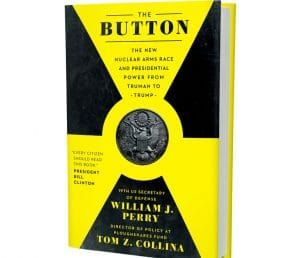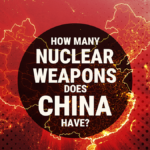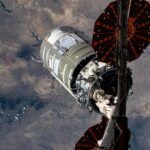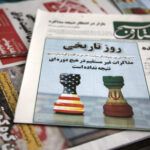The Atomic Titanic: an excerpt from “The Button”
By William J. Perry, Tom Z. Collina | June 19, 2020

The story of nuclear weapons will have an ending, and it is up to us what that ending will be. Will it be the end of nuclear weapons, or will it be the end of us?
—Beatrice Fihn, accepting the 2017 Nobel Peace Prize
The RMS Titanic was steaming through the North Atlantic from Southampton to New York on April 15, 1912, when the impossible happened. The unsinkable ship struck an iceberg and sank, killing more than 1,500 people. It was one of history’s deadliest peacetime marine disasters.
Until the moment of impact, all was fine. In fact, the false impression that the ship was “unsinkable” may have caused overconfidence among the crew that led them to take greater risks than they otherwise would have.
Similarly, the fact that we have lived with nuclear weapons for seventy-five years has lulled us into a false complacency. To those who say, “We have had nukes this long and all is well, so what’s the problem?” we say, “The extreme dangers are there, lurking just beneath the surface, and you don’t even see them. Look closer and you will.”
“So, we’re almost like passengers on the Titanic,” former California Governor Jerry Brown said in 2019. “Not seeing the iceberg up ahead but enjoying the elegant dining and the music. The business of everyday politics blinds people to the risk. We’re playing Russian roulette with humanity. And the danger and the probability [are] mounting that there will be some nuclear incident that will kill millions, if not initiating exchanges that will kill billions.”
We agree with Governor Brown. US nuclear policy is a disaster waiting to happen, and it could be only a matter of time until our luck runs out. The Cold War is over, and we have had thirty years to rethink US nuclear policy. Yet through the administrations of George H.W. Bush, Bill Clinton, George W. Bush, Barack Obama, and now Donald Trump, we have failed to learn the correct lessons from the Cold War. Each president sought to rearrange the deck chairs on the Titanic, but none set a new course away from the icebergs.
===
Unlike all other instruments of war, nuclear weapons are the president’s weapons. Only the commander in chief can authorize their use. With this authority comes the responsibility for presidents to take the lead on transforming nuclear policy so these weapons are never used again.
And unlike all other nations, the United States bears the greatest global responsibility to lead the world away from the bomb. America brought the bomb into the world and has in the past been the global leader in efforts to control it. The United States must once again take up the essential cause of nuclear disarmament.
Whoever is elected in 2020, the next president of the United States will have a unique opportunity to reshape US nuclear policy. The seventy-fifth anniversary of the bomb and the fiftieth anniversary of the Nuclear Non-Proliferation Treaty (NPT) will shine a bright light on our current policies that are broken and badly in need of repair.
As we have seen in these pages, the defining error of US nuclear policy is that it is focused on the wrong threat. We are preparing for a first strike from Russia that is very unlikely; what is not so unlikely is that we will blunder into a nuclear war. Yet by preparing for the surprise first strike, we actually make the blunder more likely. Our misguided policies like sole authority, first use, and launch on warning are extremely dangerous, particularly when combined with the old dangers of false alarms, the new dangers of cyber threats, and the ever-present dangers of an unstable president—even if that instability is temporary as a result of medication or over-drinking.
Meanwhile, instead of fixing these glaring problems, the United States is doubling down on them by spending more than a trillion dollars to rebuild its nuclear arsenal as if the Cold War had never ended. We could increase our security while at the same time saving hundreds of billions of dollars by shifting to a policy of second-strike retaliation and phasing out the weapons that are most prone to be used first and quickly, such as ICBMs.
In addition, the United States and Russia are rushing into a nuclear arms race that neither side can win. Washington and Moscow are tearing down the arms control structures that served them so well over the last fifty years. It is vital to our security that these structures be preserved, and that we continue the process of reducing nuclear arsenals. But we cannot get there unless we address missile defense, the third rail of nuclear arms control.
As the Cold War neared its end, Reagan and Gorbachev came to realize that the vast nuclear arsenals we had were not necessary for our security and in fact posed existential dangers to both countries. They began to reverse the nuclear buildup, even discussing the total elimination of nuclear weapons. Perhaps the greatest legacy of those two leaders was their oft-stated judgment: “A nuclear war cannot be won and must never be fought.”
That assertion is an excellent starting point for crafting a new nuclear policy: one that recognizes that neither Moscow nor Washington will initiate an unprovoked nuclear attack on the other; that greatly lowers the danger of nuclear war by a technical or political miscalculation; that significantly reduces the number of nuclear weapons; and in which no nation uses nuclear weapons to threaten another nation. All nuclear‑armed states should move quickly to ensure their security without nuclear weapons and, in time, eliminate their nuclear stockpiles.
The United States needs to learn the right lessons from the Cold War—the real danger is that we could accidentally bring on a nuclear catastrophe. We need to change gears and design a nuclear force and policies to minimize this danger. This will save money, prevent a new arms race, and make us all safer.
Significant changes in US nuclear policy will not happen without broad public awareness and support. The issue of presidential sole authority—who has his or her finger on the button—has become the most resonant nuclear policy issue in forty years, since the nuclear freeze movement in the 1980s.
We are all on the atomic Titanic, and the ship is headed for a hidden iceberg. To steer away from disaster, the United States must make major changes to its nuclear policies.
Top ten recommendations
Here are our top ten recommendations for a safer world:
1. End presidential sole nuclear authority. Retire the “football.”
The US Constitution gives Congress the sole authority to declare war. Certainly, using nuclear weapons to attack another country would be the ultimate expression of waging war, so that authority lies with Congress. During the Cold War, policies evolved that effectively set aside the Constitution by giving to the president the sole authority to launch nuclear weapons. We no longer live in a world—if we ever did—where one person should have the absolute power to end life on earth.
Presidential sole authority was first adopted to place the decision to use the bomb firmly in the hands of civilians, which we fully support. But there is no need to limit this authority to just one civilian. In the case of first use, we support current legislation to require a declaration of war by Congress that specifically authorizes a nuclear attack before the president can use nuclear weapons. First use should require the shared authority of the legislative and executive branches.
In the case of retaliation to a nuclear attack, sole authority may be justified, but only after such an attack has been confirmed by actual detonations (in other words, launch on warning would be prohibited; see below). At this point, the nation would be in a state of war, and the president would have the authority to launch nuclear weapons without seeking the approval of Congress. Even in that case, we believe that the president should try to consult with senior advisors before launching a nuclear retaliation.
Thus, sole presidential authority should be allowed only in retaliation to a confirmed nuclear attack on the United States (or an ally covered by our extended deterrent). As such, there would be no need for the president to launch nuclear weapons quickly, within minutes. There would be time for a measured response. If a nuclear attack appears to be underway against the United States, the president, rather than worrying about launch options, should use these precious minutes to get to a secure location to establish communications with civilian and military advisors. There would no longer be a need for a military aide to follow the president, 24‑7, with the emergency satchel. It is time to retire the football.
2. Prohibit launch on warning.
As discussed, launching nuclear weapons on warning of attack but before the attack can be unambiguously confirmed is just too dangerous to be contemplated. There is simply no realistic scenario that justifies a decision to launch nuclear weapons within minutes given the inherent dangers of doing so. Given the tremendous consequences of the decision (the fate of the world) and the mind‑crunching time pressure (ten minutes or less) to make such a decision, it is not worth the risk. In addition, the president would likely be working with incomplete information (Kennedy, Cuban Missile Crisis); could be under the influence of alcohol (Nixon); could be responding to a false alarm caused by equipment malfunction (Carter); or could have a predisposition to act impulsively on what could be a false alarm caused by a cyberattack (Trump).
Simply put, the stakes are far too high for the United States to ever launch nuclear weapons unless we are absolutely sure that we are under nuclear attack. Once an attack is confirmed, the United States would still have a survivable second-strike force based on submarines at sea. We should never rush into nuclear war, even in retaliation.
3. Prohibit first use.
Given US conventional superiority, we believe that no rational president would use nuclear weapons first, in any scenario, and thus US threats to do so are not credible. Against a nuclear-armed state like Russia, first use would be suicide in the face of assured retaliation. Against a nonnuclear state, first use would start a race among such states to go nuclear, make the United States into an international outcast, and go against fifty years of US nonproliferation policy. How can we possibly convince other states that they do not need nuclear weapons if the United States itself says it needs them for nonnuclear threats? We would be stepping back in time to a nuclear wild west.
Nuclear weapons serve no practical military purpose other than to deter their use by others. The United States can deter and respond to other threats (biological, chemical, and conventional) with its unmatched conventional arsenal. In the past, some US allies have urged the US to retain a first-use policy. US allies need to be reassured that a policy of no first use does not undermine Washington’s commitment to their security.
The United States can make a policy of no first use more credible by adjusting its nuclear forces accordingly. ICBMs have no role other than as first-strike weapons (they would not survive a first strike by Russia) and should be phased out. Until then, ICBMs should be taken off alert in a verifiable way, such as storing warheads separately from missiles. The US strategic bomber fleet is already de‑alerted, with bombs stored in bunkers. Washington and Moscow could work together to develop ways to reduce the first-strike threat from submarines at sea by, for example, limiting their deployment areas away from each other’s coasts.
Finally, a credible US no-first-use policy could encourage Russia to follow suit and back away from its hair-trigger launch status. The danger of Moscow blundering into nuclear war because of its first-use and high-alert policies is probably even greater than in the United States. Thus, it is in the US national security interest to do what it can to nudge Russia away from first use and into a second-strike-only posture.
We support current legislation that would make it US policy to not use nuclear weapons first. This would supplement legislation to limit presidential sole authority—a “belt and suspenders” approach to prohibiting first use. A no-first-use policy could also be achieved by executive order.
4. Retire all ICBMs and scale back the nuclear rebuild.
Retiring ICBMs would solve a number of problems for US nuclear policy. It would reduce the pressure to launch on warning and “use them or lose them”; make US no-first-use policy more credible; and save hundreds of billions of dollars that could be redirected to higher-priority projects.
Without first use, ICBMs would have no legitimate purpose. Most of them would be destroyed by a Russian first strike and would be unnecessary in any other scenario. The ICBMs are simply not needed for an effective response, which would be carried out by submarine-based weapons. ICBMs are not worth keeping as a “nuclear sponge,” as this only increases the nuclear danger to the US Upper Midwest and surrounding states. Drawing a nuclear attack to the United States rather than away from it makes no sense.
US plans to spend about $150 billion to build a new generation of ICBMs are not only a waste of taxpayer money, but deploying those weapons would make us less safe. The ICBMs are, at best, extra insurance that we do not need; at worst, they are a nuclear catastrophe waiting to happen.
The ICBMs are part of a larger effort to spend about $2 trillion on rebuilding and maintaining the US nuclear arsenal over the next thirty years. This effort is excessive. The United States should build only the weapons it needs for second-strike deterrence and should not go beyond that for obvious reasons: the weapons are expensive and dangerous.
The US nuclear-armed submarine force alone is sufficient for assured deterrence and will be so for the foreseeable future. But as technology advances, we have to recognize the possibility of new threats to submarines, especially cyberattacks and detection by swarms of drones. The new submarine program should put a special emphasis on improvements to deal with these potential threats, ensuring the survivability of the force for decades to come.
In the context of no ICBMs, we believe that a fleet of ten new nuclear-armed submarines would be more than adequate to meet our country’s deterrent needs. The firepower on board just five or six survivable submarines would be enough to destroy the vital elements of state control, power, and wealth in Russia, China, and North Korea. In fact, just one boat can carry enough nuclear weapons to place two thermonuclear warheads on each of Russia’s fifty largest cities.
The Trump administration is fielding new “low-yield” nuclear warheads on Trident submarine-based missiles. These dangerous weapons are a bad solution to a nonexistent problem. The United States can deter the unlikely Russian use of its low-yield bombs with its current arsenal. There are no “gaps” in the US deterrent force, and there can be no doubt in Russia’s mind that the United States is serious about maintaining an unambiguously strong nuclear deterrent.
Trump’s program calls for development of a new bomber, the B-21, with improved stealth capability. We support that program because it is a useful addition to our conventional forces and because it provides backup should the submarines ever suffer a temporary problem that raises a question about their capability. This is not likely, but the bomber force is an insurance policy for that contingency.
Moving from first use to second-use assured retaliation means that the command and control system can shift from quick launch options to providing more decision time for the president. We do not need weapons on high alert and the ability to launch on warning of attack. But we do need a survivable system that protects the president and his or her ability to issue orders under the most stressful conditions imaginable.
The United States should prioritize command and control modernization over rebuilding its nuclear weapons. The president should not feel rushed into a launch decision, and we should seek to extend the time frame well beyond an attack. This would better allow the president to reassess the post-attack situation and prudently direct the operations of surviving forces.
As the United States plans for the future of the nuclear arsenal, we can move to a smaller but more secure second-strike force whose sole purpose is to deter nuclear attack. We do not need to spend hundreds of billions more in a dangerous and futile attempt to “prevail” in a nuclear conflict.
By phasing out ICBMs and building fewer new submarines and bombers, we estimate that the United States could save at least $300 billion ($10 billion per year) and still field a formidable deterrent force.
5. Save New START and go farther.
The New START Treaty, negotiated by the Obama administration and signed by the United States and Russia in 2010, is the last major agreement still in force limiting nuclear arms, and it expires in February 2021. It can be renewed for five years, but only if Washington and Moscow agree. President Trump may do nothing or oppose extension. In that case, a new president who takes office in January 2021 would have just weeks to pick up the pieces.
President Trump should resist efforts to complicate New START extension. Yes, Russia is developing new nuclear weapons not covered by the treaty, and yes, China is not in the treaty at all. Options to address these issues can be explored for a follow-on agreement but will simply take too long to consider by early 2021. In fact, we believe that the proposal to include these issues in the New START extension is simply a spoiling effort by those opposed to New START.
Abandoning New START would be a tragic error that would throw gasoline on the arms race fire. New START has served the United States well, and there are no indications of Russian violations. It deserves to be renewed. It limits the number of nuclear weapons that Russia can aim at the United States, and it gives Washington confidence that Moscow will not expand its arsenal quickly. Without New START, those assurances disappear. New START is also the vehicle for the last remaining dialogue we have with Russia on nuclear weapons. Indeed, one of the most important reasons for strategic arms treaties is to maintain a continuing dialogue on these issues that affect the survivability of both of our countries.
However, it would be a mistake for Congress to allow the Trump administration to hold the treaty hostage and, as ransom, demand support for the administration’s excessive nuclear modernization program. As much as we want New START extended, this is a price not worth paying.
Even if New START is extended, it cannot be the end of the arms control road. Both Moscow and Washington would still retain enough nuclear firepower to destroy the world for themselves and everyone else. We must continue to drive numbers down so that if nuclear war does break out, it does not result in the end of civilization. Climate science tells us that a hundred or more high-yield nuclear warheads detonated on large cities could so damage the climate as to cause a major deterioration of life on Earth. We cannot consider the arms reduction process truly successful until it brings the numbers down to this level and below.
After New START, President Obama had planned to negotiate a follow-on treaty with Russia to reduce deployed strategic nuclear forces by one-third, or down to about a thousand warheads. This could serve as the starting point of renewed talks with Moscow.
As part of this effort, presidents Trump and Vladimir Putin should announce a joint declaration reaffirming that a nuclear war cannot be won and must never be fought. This would renew the 1985 Reagan-Gorbachev statement that Americans and Russians received positively as the beginning of an effort to reduce risk and improve mutual security. A joint statement today would clearly communicate that despite current tensions, leaders of the two countries possessing more than 90 percent of the world’s nuclear weapons recognize their responsibility to work together to prevent a global catastrophe. This could also lead other nuclear states to take further steps to reduce nuclear risk. The timing of such a statement would also signal Washington and Moscow’s commitment to build on past progress toward disarmament.
We fully understand that US-Russian relations are at a historic low and that building political support for new negotiations will be challenging. But the importance of reducing global nuclear dangers should be clear to all and transcend political calculations on nonnuclear issues. Whatever their other areas of disagreement, leaders in Washington and Moscow should always be willing to talk about avoiding nuclear war.
6. Limit strategic missile defenses.
It will be next to impossible to continue with significant arsenal reductions without real limits on strategic missile defenses. As long as Russia sees US missile defenses as a threat to its ability to retaliate after a US first strike, Moscow will refuse to negotiate major new arms reductions without limits on US defenses. And as long as the US Congress remains under the mistaken belief that these systems can be made to work effectively, it will refuse to limit national defenses.
After spending well over $300 billion on strategic missile defense programs since 1983, the more Washington spends to deploy missile interceptors and develop space weapons, the more Moscow will resist reducing its nuclear forces and the more Beijing will build up. This will put an inevitable brake on how far we can get in the reduction of nuclear weapons. Russia and China are also concerned about US regional missile defenses, such as US sea- and land-based interceptors in Europe, Japan, and South Korea.
One way to address this problem is to seek to convince the US Congress that long-range missile defenses are not as effective as represented. A main reason why Congress is under the delusion that US interceptors are effective is that they have not been tested against realistic threats. The George W. Bush administration deployed a deeply flawed system, and it has regrettably won bipartisan support. But we should not expand it or add to it in any way until those systems have been run through independent, realistic tests, including real-world countermeasures. We do not believe that the US strategic missile defense system will pass such realistic tests. We should not continue to spend billions on systems that are not effective and that lead us to a false sense of security.
We are making strong statements about missile defense, but the future of the US program need not be based on our negative assessments. We also need independent technological assessments. Congress should fund an independent organization to review the numerous proposed anti-missile technologies. A 1987 report by the American Physical Society (APS) on the feasibility of directed energy weapons helped scale back the SDI program. A similar study by APS on current anti-missile systems would be a boost to congressional oversight and public understanding of these complex technologies.
Ultimately, Washington and Moscow will need binding limits on long-range missile interceptors, as existed in the ABM Treaty until it was abandoned by the George W. Bush administration in 2002. It is hard to imagine securing Moscow’s support for further arsenal reductions without such binding limits.
7. Don’t wait for treaties.
As much as we support the use of legally binding treaties to secure limitations on nuclear weapons and missile interceptors, unfortunately, we can no longer count on this approach to succeed. The Comprehensive Test Ban Treaty (CTBT) was rejected in 1999 by a Republican Senate even though it would clearly serve US interests. The New START Treaty barely made it through a Democratic Senate and did so only after the Obama administration promised it would rebuild nuclear forces and not allow limitations on missile defenses. Meanwhile, Republican presidents, who have a long history of supporting arms control, have now turned against it. As a result, there may be no way to get future arms control treaties through the Senate.
The sad reality is, for the foreseeable future, we cannot count on the US Senate to produce 67 votes for arms control measures, even if those measures are clearly serving US national security interests.
But these issues are too important to sit by and wait for a change in the composition of the Senate. If political support in the Senate does not exist for prudent agreements on arms reductions, the next president should pursue them through executive agreements and other means that do not require ratification by the Senate. This is far from ideal but still better than nothing.
It is true that political agreements may be more vulnerable to being reversed by the next president, as shown by Trump’s withdrawal from Obama’s nuclear deal with Iran. But it is also true that presidents can just as easily withdraw from treaties, as Trump did with the INF Treaty and Bush did with the ABM Treaty. Treaties are not our only path to progress, and if partisan politics make treaties impossible, then we must pursue other means.
8. Engage diplomatically with North Korea and Iran.
The next president should seek to use diplomacy to contain nuclear programs in North Korea and Iran. Such efforts are essential to restraining regional arms races as well as for allowing truly deep reductions in US and Russian forces. There are no viable military solutions to either situation, and such actions should be avoided.
On Iran, the next US president should reenter the Iran nuclear agreement negotiated by Tehran and the United States, Russia, China, and the European Union. According to international inspectors, Tehran was complying with the 2015 Joint Comprehensive Plan of Action (JCPOA) when the Trump administration withdrew from the agreement in 2018. Trump’s ill-advised action has only served to set back the goal of preventing Iran from developing nuclear weapons. The next president should seek to rejoin the JCPOA and begin to rebuild good relations with Tehran toward the possibility of negotiating a follow-on agreement to extend international limits into the future.
North Korea, by contrast, already has nuclear weapons and poses an even tougher diplomatic challenge. We support President Trump’s effort to engage directly with North Korean leader Kim Jong-un, but so far the administration has not demonstrated that it has a viable negotiating strategy. Rather than asking the North to surrender its nuclear arsenal at the start of a diplomatic process, the United States should seek to build a fundamentally new relationship with Pyongyang such that North Korea no longer fears unprovoked military action by the United States, and South Korea no longer fears unprovoked military action by North Korea. Such a transformed relationship will take time and patience.
The Nuclear Non-Proliferation Treaty (NPT) will mark its fiftieth anniversary in summer 2020. The treaty and its 190 member-states play an important role in stopping the spread of the bomb to additional countries. The great majority of the states without nuclear weapons support the UN treaty to eliminate the bomb and are frustrated that the United States and Russia have not made more progress on nuclear disarmament and are, in fact, abandoning arms reduction treaties and rebuilding their nuclear forces. In this regard, Moscow and Washington could build much-needed support for the NPT process by extending New START and working to bring the CTBT into force.
9. Bring the bomb into the new mass movement.
As we saw in chapter 9, even if a new president is committed to transforming US nuclear policy, once in office, she or he will face tremendous political headwinds and institutional resistance to change. To overcome these barriers, a new president will need to come into office with a clear plan of action that can be implemented quickly, and put the right staff in the most influential positions to enact that policy.
As in the case of President Obama, once the election is over, there will still be a need for pressure from outside organizations and American voters. There should be a powerful outside constituency to remind the president of promises made and that there will be a political cost if progress is not achieved.
Public education is essential (and is the reason we wrote this book). But we know this is just the beginning. There should also be tweets, op-eds, articles, podcasts, speeches, conferences, YouTube videos, TV shows, documentaries, and mainstream movies. The goal is to change the way the public and popular culture view nuclear weapons. The weapons need to be seen not as an asset, but as a liability—indeed, an existential danger.
The Nuclear Freeze campaign peaked thirty-eight years ago with a million people protesting the arms race in 1982 in New York City’s Central Park. We do not have a similar movement today, but we do have a transformed mass movement that was born soon after the election of President Trump. This popular uprising is focused on women’s rights, immigration, justice, democracy, war prevention, gun control, and the environment; it could also focus on nuclear disarmament.
We need to bring the bomb into the new mass movement. Highly effective organizations like Indivisible, MoveOn, and others are leading the way. We stand ready to help however we can.
10. Elect a committed president.
Finally, it all comes down to electing a president who cares about avoiding nuclear war and changing US nuclear policy. This policy must change from the top, and only the president can drive that process. Nothing will change unless the president wants it to change. American voters need to educate themselves on what the presidential candidates think about nuclear weapons and what the candidates will do if elected. So, we ask all of you who are eligible to vote in the 2020 US presidential election and thereafter: please vote as if your life depends on it.
Today, with the Cold War thirty years behind us, the United States still has massive nuclear forces deployed to respond immediately to a surprise attack, and the president has unchecked authority to start a nuclear war. US nuclear policy is stuck in a time warp, essentially unchanged since the 1950s.
The framers of the Constitution could not have foreseen the challenges that would be posed by the atomic age, but they did understand the dangers of an unchecked president. The bomb and how we manage it have caused great damage to American democracy and security by undermining congressional authority and bestowing superhuman powers to the commander in chief.
There is no justifiable need to give any president the unilateral power to end the world within minutes. As the bomb turns seventy-five, there is no better way to reduce the danger of nuclear catastrophe than by getting rid of the nuclear button.
We wrote this book with the hope that by reframing how we think about the bomb’s past, we could help change the bomb’s future. But that ultimately depends on you, the reader. The public must get more actively involved if we expect our national leaders to push for a new nuclear policy. We know this is possible, because we have seen it happen before. The United States and Russia ended the first nuclear arms race because of public pressure. The UN approved a global ban on nuclear weapons because of public pressure. And we will end sole authority, stop a new arms race, and build a safer world in the same way.
Today, nuclear weapons pose the underappreciated danger to the very existence of our civilization. No one of us alone can alter that reality, but together we can act to give this vital issue the time and attention it rightly deserves.
Together, we make the world safer.
The Bulletin elevates expert voices above the noise. But as an independent nonprofit organization, our operations depend on the support of readers like you. Help us continue to deliver quality journalism that holds leaders accountable. Your support of our work at any level is important. In return, we promise our coverage will be understandable, influential, vigilant, solution-oriented, and fair-minded. Together we can make a difference.
Keywords: The Button, William Perry, accidental nuclear war, book excerpt, nuclear blunder
Topics: Nuclear Weapons

















What an interesting book. And timely too! People who enjoy this book will also like another book I read not long ago titled ” Bomboozled: How the U.S. Government Misled Itself and It’s People Into Believing They Could Survive A Nuclear Attack” By Susan Roy. She outlined a situation that if it wasn’t so sad it would be laughable. One would think the Cuban Missile Crisis in and of itself would have done it. Haven’t we been here before? Yogi Berra ” It’s deja vu all over again” . Maybe if we write enough books a politicain will eventually read… Read more »
You may be interested in my series of articles on Medium about the early history of nuclear weapons .
The first one is Uncle Sam’s New Clothes, part 1
—————